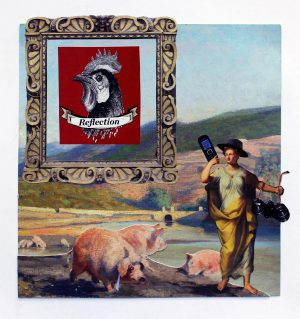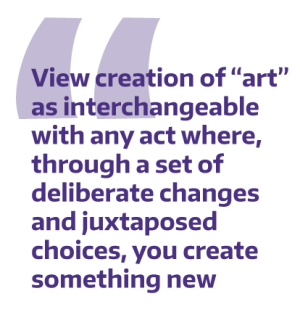
Yoga Month Week 3: Getting Creative

A paper collage made by Jeanette Henderson, executive director, UW Real Estate with UW Facilities.
The act of creation is central to almost every element of human life.
When we cook, we combine an assemblage of ingredients to create nourishing meals. When we gather in groups, we create conditions for shared interactions that yield a sense of safety and belonging.
Similarly, when setting daily intentions, weekly schedules, and long-term plans, we’re creating by ordering our time to produce a new and desired outcome or accomplishment.
As part of UW Yoga Month this October, we’ve explored how yoga practice can go well beyond what you do on the mat to encompass a more mindful awareness of one’s surroundings and place within them. In Week 1, we looked at inspiration. In Week 2, nature.
This week, we focus on how acts of creation—specifically making things in the form of images and words—can serve as explorations space, range, form, and function much in the same way yoga does.
This week, your off-mat challenge is to create something. It doesn’t have to be a sketch or a poem—though it can be. It doesn’t have to be perfect or even close to it. You don’t even have to know what you’re setting out to create in the first place.
Just allow yourself a moment of time, a degree of space, and freedom from the usual distractions to bring something new into the world—even if it’s just for a minute.
One of my philosophies as someone who likes making things in my free time is that you can create under any condition. That’s one thing I hope participants take away from the collage workshops I’ve led at UW in the past year: that anyone can make art and you don’t need a lot of time or materials to do so; just intention and a space—physical or otherwise—that you cultivate in life for it.
Whether you’re making a cut-and-paste collage or penning a poem or reflection, if an image or word feels right when set next to another, run with it—especially because you don’t know what the outcome will be!
In 2015, Sarah Guthrie set an intention of spending at least 30 minutes a day painting at home in her basement studio—a way of incorporating her lifelong passion for making art into a busy schedule as director of communications for the University of Washington School of Pharmacy. “It seemed like an almost impossible challenge,” she recalls. “But in the end it really grew my practice.” That daily practice led Guthrie to challenge herself to make 365 paintings in a year. She says a key to sustaining and centering her process each day was asking the question: “what colors bring you joy?”
Conquering fear of the blank canvas–of creating something from nothing—is no small thing. But you’ll always be better off for trying! Take Doug Jeck, who teaches an intermediate level sculpture class in which he asks UW students to create life size ceramic figures.
“It’s a really, really challenging class,” he says. “What’s difficult is, from the first day of class until [the final critique], they’ve had one thing to do and that is to get something that’s more or less life-size to make it through a kiln firing and get it to stand up. It’s process of sustained labor and vision you don’t see much of these days.”
A nationally renowned sculptor of clay and the human form whose work bridges ceramics, photography, and performance art, Jeck is best known for his figurative sculpture. However, he prefers the term “human objects,” which he says “not only describes the uncanny presence of the thing I make, but also refers to the focus of its content.”

The “content” to which Jeck refers mean any number of thoughts and encounters he has as he works on a given piece, slowly building a hollow human body and day-by-day adding thin strips of clay on top of another inches at a time until features begin to emerge.
He encourages students to think of their sculpture space as the reverse of an archaeological site: instead of stripping away layers, they are accumulating those thoughts and experiences around the work at hand until the end-result is greater than the sum of its parts.
“It’s your narrative that gets embedded in the thing just by osmosis. At the end, all they can do is look at these things in an exercise of gestalt—aesthetic arrest,” he says, referencing a way of seeing in which one can’t dismiss something as quickly as you might otherwise. “All you can do is stand before it and behold it.”
Thus, making art with images or words can be viewed as a tangible act of momentarily setting oneself aside and into something else. I encourage you to view creation of “art” as interchangeable with any act where, through a set of deliberate changes and juxtaposed choices, you create something new.
Share your own artwork or other means of creative expression with us here!
To learn more about this month’s yoga activities, register to join UW Yoga Month 2019! A very special thanks to our sponsors BECU, US Bank, and AT&T as well as to UW Recreation.